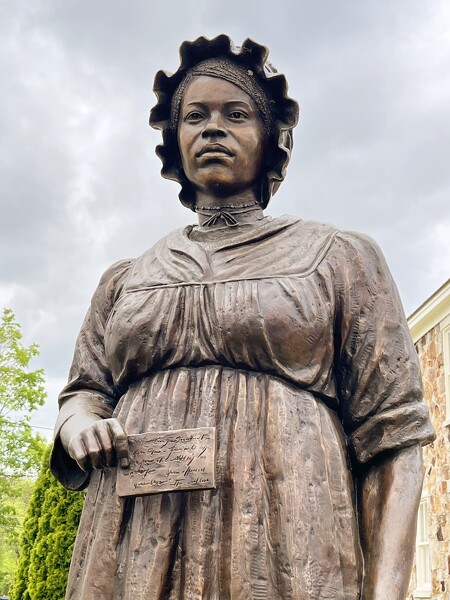ST. MARYS - The Declaration of Independence is a significant historical document as it has served as inspiration for other countries' independence and different groups' missions, while also making the argument that seceding from England was a necessary cost for democracy in the American colonies.
About 30 people attended "The Two Declarations: The Declaration in 1776 and the Declaration through Time," an event hosted Wednesday night by the Auglaize County Historical Society. Thomas T. Taylor, a history professor at Wittenberg University in Springfield, discussed the duality of the document - how it is a living document while also providing a list of crimes King George III committed against the American people.
Taylor said it wasn't until the last decade or so that he saw people fiercely debating the Declaration of Independence.
"One of the things that really struck me was how many people were talking about the declaration and they basically were complaining about it, saying, 'Oh yeah, they said all that nice stuff, but they didn't mean it. They're a bunch of hypocrites or worse, they're a bunch of rich white guys writing all this stuff and you couldn't take them seriously.'"
Taylor said when he teaches the course, he wants to explore the nuances of the document, including that remarkable duality. He tells his students the declaration is the "nation's birth certificate."
"But it also took on a different life afterward," Taylor said of the document's evolution. "I think of it as the national agenda, because generation after generation, we go back to that document and ask the question: 'What do we need to do to live up to that?'"
Different generations thought they needed to do different things to live up to those ideals, he said.
Taylor said when the declaration was ratified, it didn't spark immediate patriotism.
"It was read around the country…. but it's not like it turned into this grand national celebration right away," he said. "They had a war that went on for seven to eight years and even immediately after that, people recognized independence, but the declaration itself took a while before that kind of observation really took hold. The ideas, it turns out, almost immediately started affecting people in ways that the guys who wrote it didn't even see coming."

Elizabeth Freeman sued for her freedom and won. Her statue is in Sheffield, Mass.
Image via The Trustees
An obvious example of the declaration's influence came with the ratification of the Constitution a few years later. After the Constitution was ratified, most states had to update their constitutions because the original text came from charters that had been given by the King of England, who the American people had told to "drop dead or at least stay there," Taylor said.
Much of the language states adopted came from the declaration. Massachusetts, on the other hand already had a state constitution partly authored by Boston's John Adams, a signer of the declaration, who had added a clause to the state's 1780 constitution that said "all men are born free and equal."
As a result, Elizabeth Freeman became one of the first enslaved African Americans to successfully file and win a lawsuit for her freedom in Massachusetts. She argued the newly adopted state constitution condemned slavery as illegal. The Massachusetts Supreme Judicial Court ruling - in Freeman's favor - found slavery to be inconsistent with the 1780 Constitution of Massachusetts.
In the 1790s and early 1800s, more and more people started to found anti-slavery societies that were inspired by the "all men are born free and equal" phrase, Taylor said.
Similarly, when the Seneca Falls Convention in 1848 eventually formed the Declaration of Sentiments, a document outlining the injustices women faced at the time, it took inspiration from the declaration.
"(Former President Abraham) Lincoln said the declaration became like a living document; it's got its own life and later generations start to apply it to their own life," Taylor said. "If that hadn't happened, it's kind of a dead letter in history, is the way he saw it. The document does take on a life of its own. No, it's not the life that the people of the 1770s could have predicted, because how could they know?"
Other countries saw the independence America was fighting for and joined in, Taylor said. More revolutions erupted after the American Revolution.
"It's sometimes called the Age of Revolutions," he said, "What's interesting is how many times they (other counties) refer back to the arguments of the Declaration of Independence. Now, I'm not saying the American Declaration caused all of their revolts. They had plenty of reasons to reject the Spanish authority, but you see how the declaration affects people."
Taylor said he questions the argument that the founding fathers were "hypocrites" and didn't believe in what they were drafting.
The list of crimes America accuses King George III of may not necessarily compute as significant to the average American today because they were not alive then.
"My point is that when people read the declaration in that generation, they knew what these things referred to," he said. "They're not abstractions; they're real events."
Of the list of grievances, Thomas Jefferson wrote that "He (King George III) has plundered our seas, ravaged our coasts, burnt our towns, and destroyed the lives of our people."
In the fall of 1775, up through early 1776, Lord Dunmore, the last royal governor of Virginia, had amassed a small army and naval force and attacked several towns on the Virginia coast, and along the colony's inland rivers, according to the National Parks Service.
Taylor said Jefferson is referring to specific incidents that enraged the American people.
"When the text came into (the Continental) Congress, you can bet those members of Congress recognized the references because a lot of them happened in their colony," he continued. "These things, again, are not abstractions. These are personal to the people in that generation. It's just we don't remember them very much."
Taylor also defended Jefferson for his first draft of the declaration.
After Adams and Benjamin Franklin urged Jefferson to write the declaration, his first draft, which Congress tore into, addressed slavery and how the monarch created the system. Congress removed that section.
"As for Jefferson, he maintained for the rest of his life that Congress had mangled it," Taylor said. "He did not think their changes were improvements. He thought his original was better."
In that original paragraph, Jefferson blames slavery on the King of England, saying "it was the king's Royal African Company that started slavery out here in the first place," Taylor said.
"In Jefferson's view, his generation had inherited slavery - it didn't cause it. He didn't write 'all men are created equal' and not think, 'what about my slaves?' He knew he had a problem," Taylor continued.
For the colonists of the time, Taylor argues, the declaration was describing a failed effort to reconcile with England.
"'At a certain point, we're entitled to do this,'" he said of the rationale the declaration depends on. "That's the philosophy. But this list of crimes is the evidence they're at that point. For that generation, that's what the declaration would have been."
"I think the point is the revolution for them was about something rather specific, but over time, the declaration has been about a lot of other things that matter to us and rightly so," Taylor continued. "But that's not contradiction. That's just how history changes over time."
Taylor's presentation was in conjunction with America's upcoming 250th anniversary in 2026. To commemorate the event, the St. Marys Community Public Library is hosting the new Gilder Lehrman traveling exhibit, "Declaration 1776: The Brig Bang of Modern Democracy." The exhibit uses primary sources to illustrate how Americans and people around the world were inspired by the document. The exhibit is available to view until Saturday.


